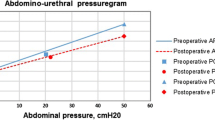Abstract
Full urodynamic assessment, including urethral profiles at rest and under stress, was made before and after surgery for severe urogenital prolapse in 40 continent women. Profilometry was also recorded after reduction of the prolapse by a vaginal pessary. The aim of this study was to try to determine criteria to prevent postoperative incontinence. After surgery, 6 patients (15%) became stress incontinent. The operation tends to diminish urethral obstruction (diminution of the residual volume) and negatively affects urodynamic urethral parameters (diminution of the residual continence area). The pessary test was not predictive of postoperative incontinence. Preoperative transmission ratio <100% and/or maximum urethral closure pressure <35 cmH2O are proposed as predisposing factors for postoperative iatrogenic incontinence. Therapeutic implications are discussed.
Similar content being viewed by others
References
Versi E, Cardozo L, Brincat M, Cooper D, Mongomery J, Studd J. Correlation of urethral physiology and skin collagen in postmenopausal women. Br J Obstet Gynaecol 1988;95:147–152
Rud T. Urethral pressure profile in continent women from childhood to old age. Acta Obstet Gynecol Scand 1980;59:331–335
Krige CF. The repair of genital prolapse combined with vaginal hysterectomy. J Obstet Gynaec Br Emp 1962;79:570–576
Read CD. Stress incontinence with special reference to failure of cure following vaginal operative procedure. Am J Obstet Gynecol 1950;59:1260–1267
Fischer W, Lamm D. Urologische Komplikation beim Genitalprolaps der Frau. Z Urol Nephrol 1978;71:857–864
Harris TA, Bent AE. Genital prolapse with and without urinary incontinence. J Reprod Med 1990;8:792–798
Walter S, Olesen PK. Urinary incontinence and genital prolapse in the female: clinical urodynamic and radiological examinations. Br J Obstet Gynaecol 1982;89:393–401
Richardson DA, Bent AE, Ostergard DR. The effect of uterovaginal prolapse on urethrovesical pressure dynamics. Am J Obstet Gynecol 1983;146:901–905
Ridley JH. Evaluation of the colpocleisis operation: a report of fifty-eight cases. Am J Obstet Gynecol 1972;113:114–119
Goldmann T, Ovadia T, Feldberg D. The Neugebauer-Le Fort Operation: a review of 118 partial colpocleises. Eur J Obstet Gynecol Reprod Biol 1981;12:31–5
Stanton SL, Norton C, Cardozo L. Clinical and urodynamic effects of anterior colporrhaphy and vaginal hysterectomy for prolapse with and without incontinence. Br J Obstet Gynaecol 1982;89:459–463
Enhorning GE. Simultaneous recording of intravesical and intraurethral pressure. A study of urethral closure in normal and stress-incontinent women. Acta Clin Scand 1961; Suppl. 276
Asmussen M. Static and dynamic pressures of the lower urinary tract as measured by simultaneous urethral cystometry, In: Ostergard D. R. ed. Gynecologic urology and urodynamics. Baltimore, Williams & Wilkins, 1985;133–166
Rai RS, Versi E. Urethral pressure profilometry. Int Urogynecol J 1991;2:222–227
Hilton P, Stanton SL. Clinical and urodynamic evaluation of the polypropylene (Marlex) sling for genuine stress incontinence. Neurourol Urodyn 1983;2:145–153
Weil A, Reyes H, Bischof P, Rottenberg R, Krauer F. Modifications of the urethral rest and stress profiles after different types of surgery for urinary stress incontinence. Br J Obstet Gynaecol 1984;91:46–55
Rottenberg R, Weil A, Brioschi PA, Krauer F. Urodynamic and clinical assessment of the Lyodura sling operation for urinary stress incontinence. Br J Obstet Gynaecol 1985;92:829–834
Bhatia NN, Bergman A, Gunning JE. Urodynamic effects of a vaginal pessary in women with stress urinary incontinence. Am J Obstet Gynecol 1983;147:876–84.
Bhatia NN, Bergman A. Urodynamic appraisal of the Bonney test in women with stress urinary incontinence. Obstet Gynecol 1983;65:696–699
Bhatia NN, Bergman A. Pessary test in women with urinary incontinence. Obstet Gynecol 1985;65:220–226
Bergman A, Bhatia NN. Pessary test: simple prognostic test in women with stress incontinence. Urology 1985;24:109–110
Stanton SL, Ritchie D. Urilos: the practical detection of urine loss. Am J Obstet Gynecol 1977; 128:461–463
Reyes H, Weil A. Reproducibility of simultaneous urethrocystometry measured with electronic microtransducers. Gynecol Obstet Invest 1983;15:129–140
Abrams P, Blaivas JG, Stanton SL, Andersen JT. The standardization of terminology of lower urinary tract function. Int Urogynecol J 1990;1:45–58
Ingelman-Sundberg A. Urinary incontinence in women excluding fistulas. Acta Obstet Gynecol Scand 1951;31:266–291
Schüssler B, Hesse U, Lentsch P, Anthuben C. Artefacts in urethrometry caused by marked genital prolapse. Neurourol Urodyn 1987;6:154–155
Walters MD. Mechanism of continence and voiding, with International Continence Society classification of dysfunction. Obstet Gynecol Clin North Am 1989;16:773–785
Weil A, Reyes H, Bischof P, Rottenberg R, Krauer F. Clinical relevance of urethral stress profile using microtransducers after surgery for stress incontinence in females. Urol Int 1983;38:363–367
Henriksson L, Ulmsten U. A urodynamic evaluation of the effects of abdominal urethrocystopexy and vaginal sling urethroplasty. Am J Obstet Gynecol 1978;131:77–82
de Gregorio G, Hillemans HG. Urethral closure pressure in women with prolapse. Int Urogynecol J 1990;1:143–145
Bergman A, Konnings P, Ballard A. Predicting postoperative urinary incontinence development in women undergoing operation for genitourinary prolapse. Am J Obstet Gynecol 1988;158:1171–1175
Author information
Authors and Affiliations
Rights and permissions
About this article
Cite this article
Weil, A., Gianoni, A., Rottenberg, R.D. et al. The risk of postoperative urinary incontinence after surgical treatment of genital prolapse. Int Urogynecol J 4, 74–79 (1993). https://doi.org/10.1007/BF00376416
Issue Date:
DOI: https://doi.org/10.1007/BF00376416




